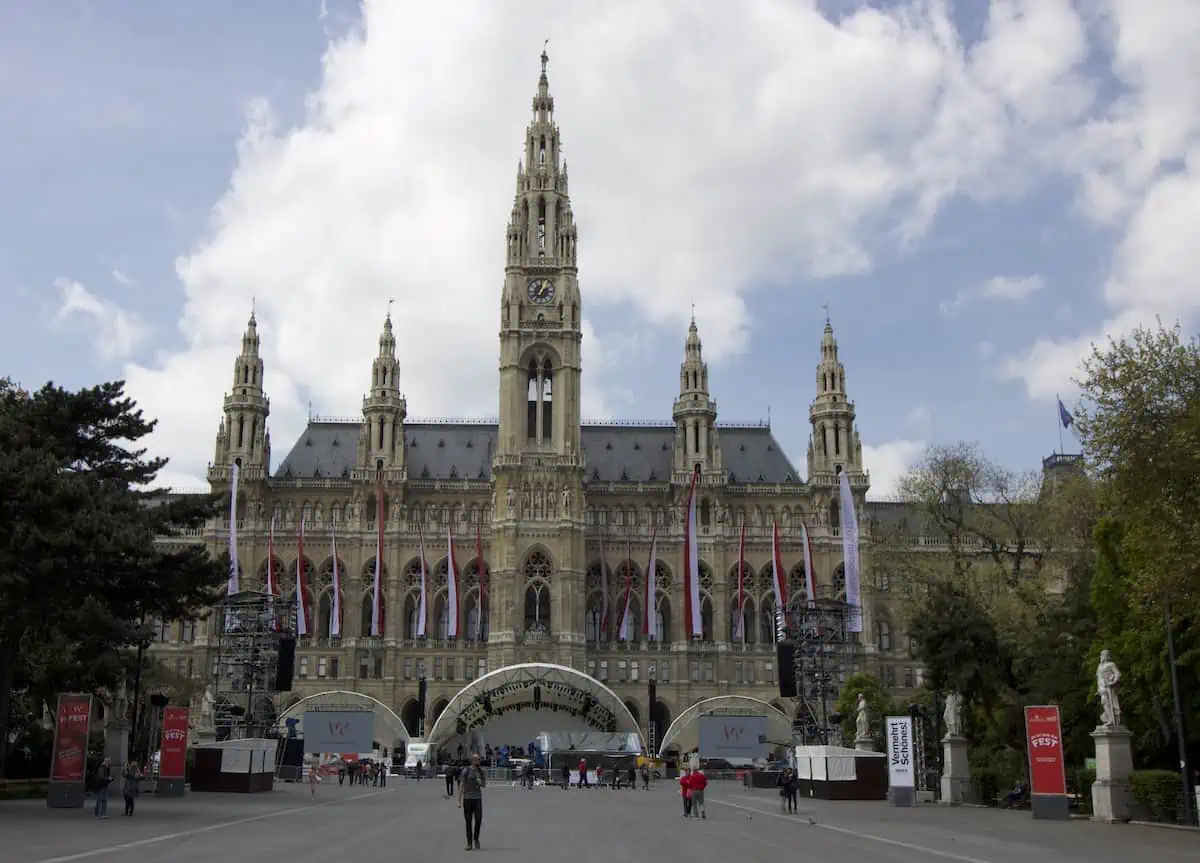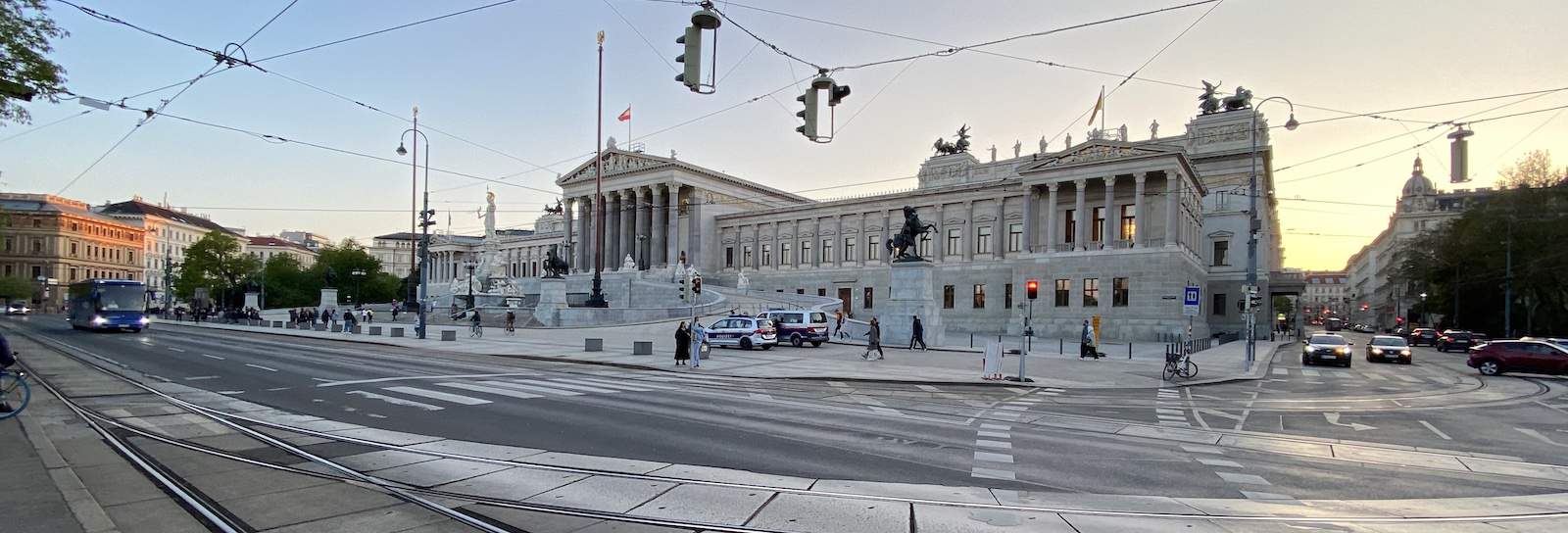The Ringstrasse is perhaps Vienna’s most iconic boulevard, encircling the city’s historic center and showcasing a collection of monumental buildings that reflect its rich cultural and political heritage. Spanning approximately 5.3 kilometers, this grand avenue is home to architectural masterpieces such as the Hofburg Palace, the Rathaus (City Hall), the Kunsthistorisches Museum (Museum of Art History), the Naturhistorisches Museum (Museum of Natural History), the Staatsoper (State Opera House), and the imposing Austrian Parliament Building.
The Ringstrasse consists out the following streets:
- Burgring
- Opernring
- Kärntner Ring
- Parkring
- Stubenring
- Schottenring
- Universitätsring
- Doktor Karl Renner Ring
- Franz Josefs Kai
History of the Ringstrasse
In 1857, Emperor Franz Joseph I authorized the construction of the Ringstrasse, aiming to modernize Vienna and replace the outdated city walls with a magnificent boulevard. This ambitious project attracted affluent citizens eager to acquire plots along the future prestigious avenue. Between 1860 and 1890, numerous monumental buildings were erected, many of which have become the city’s most significant landmarks. The Austrian Parliament Building, designed by Theophil Hansen and inaugurated in 1883, stands out with its Greek architectural influences and houses over 1,600 rooms, still serving as the seat of parliament today.
Attractions along the Ringstrasse

The Ringstrasse is lined with numerous parks and green spaces, offering residents and visitors serene spots to relax amidst the city’s hustle and bustle. Notable parks include the Stadtpark, featuring the famous golden statue of Johann Strauss II; the Burggarten, home to a monument of Mozart; and the Volksgarten, renowned for its beautiful rose gardens and the Theseus Temple.
Old parliament building
The Austrian Parliament Building, an architectural masterpiece designed by Theophil Hansen, was inaugurated in 1883. Influenced by classical Greek architecture, it houses over 1,600 rooms and remains the seat of the Austrian parliament today.
Kunsthistorisches Museum (Museum of art history)
One of the most renowned art museums in the world, the Kunsthistorisches Museum showcases an extensive collection of masterpieces by artists such as Rembrandt, Vermeer, and Bruegel. The grand building itself is a work of art, reflecting Vienna’s rich cultural heritage.
Naturhistorisches Museum (Museum of natural history)
Opposite the Kunsthistorisches Museum stands the Naturhistorisches Museum, home to over 30 million specimens, including dinosaur fossils, rare minerals, and the world-famous Venus of Willendorf.
Vienna State Opera (Wiener Staatsoper)
The Vienna State Opera is one of the most prestigious opera houses in the world. Opened in 1869, it hosts outstanding performances of classical and contemporary operas, attracting music lovers from across the globe.
Burgtheater
Vienna’s Burgtheater is one of the leading German-speaking theaters in Europe. Built in 1888, this magnificent neo-Renaissance building has been a cultural hub for centuries, staging world-class performances.
Vienna Sbtock Exchange (Wiener Börse)
The Wiener Börse, Vienna’s stock exchange, has been a financial center since 1771. The historic building on the Ringstrasse, with its grand façade, reflects the city’s long-standing economic significance.
MAK – Museum of Applied Arts
The Museum of Applied Arts (MAK) is dedicated to contemporary design, architecture, and decorative arts. It features innovative exhibitions that blend historical craftsmanship with modern artistic trends.
Vienna City Hall (Rathaus)
The Rathaus is one of Vienna’s most striking landmarks, built in a neo-Gothic style. It serves as the seat of the city’s government and hosts various events, including the famous Christmas market.
Kursalon Wien
A stunning 19th-century concert hall, Kursalon Wien is known for its elegant classical concerts, especially those featuring the music of Johann Strauss. The building is a masterpiece of Renaissance Revival architecture.
Votivkirche
The Votivkirche is a breathtaking neo-Gothic church, built as a token of gratitude after Emperor Franz Joseph survived an assassination attempt. Its soaring spires and stained-glass windows make it one of Vienna’s most impressive churches.
University of Vienna
Founded in 1365, the University of Vienna is one of the oldest universities in Europe. The grand main building on the Ringstrasse reflects the institution’s prestigious academic legacy.
Heldenplatz (Heroes’ Square)
Heldenplatz, located in front of the Hofburg, is a historic square where many significant events in Austrian history took place. It is surrounded by majestic imperial architecture and monuments.
Hofburg Palace
Once the residence of the Habsburg emperors, the Hofburg Palace is now a sprawling complex that houses museums, the Spanish Riding School, and the office of the Austrian president.
The Parks Along the Ringstrasse
The Ringstrasse is not just home to stunning architecture but also beautiful green spaces where visitors can relax and escape the city’s hustle and bustle.
Stadtpark
Stadtpark is one of Vienna’s most famous parks, featuring the iconic golden statue of Johann Strauss II. It’s a perfect place for a leisurely stroll amid lush greenery.
Sigmund Freud Park
Named after the famous psychoanalyst, Sigmund Freud Park is a tranquil spot near the Votive Church, offering seating areas for relaxation.
Volksgarten
The Volksgarten is known for its stunning rose gardens and the neoclassical Theseus Temple. It is one of the most picturesque parks along the Ringstrasse.
Exploring the Ringstrasse by tram
One of the most convenient ways to experience the Ringstrasse is by taking the Vienna Ring Tram. This tram offers a complete loop around the Ringstrasse, providing passengers with informative commentary about the historic buildings and landmarks along the route. It’s an excellent option for those looking to get an overview of Vienna’s architectural splendors in a short amount of time.
Cycling the Ringstrasse
For a more active exploration, cycling along the Ringstrasse is highly recommended. The wide boulevards are equipped with dedicated bike lanes, making it safe and enjoyable for cyclists. Renting a bike allows you to explore at your pace, with the freedom to stop and admire the various attractions, take photographs, or enjoy a coffee at one of the many traditional Viennese cafés dotted along the route.
In summary, the Ringstrasse is not just a circular road but a testament to Vienna’s historical evolution, architectural grandeur, and cultural richness. Whether you’re walking, taking the tram, or cycling, traversing the Ringstrasse offers an immersive journey through the heart of Vienna’s illustrious past and vibrant present.

